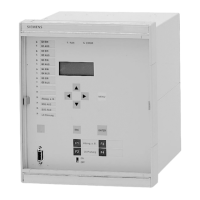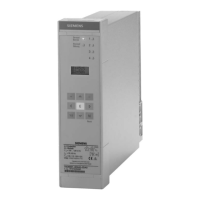Functions
2.8 Earth Fault Protection in Earthed Systems (optional)
SIPROTEC, 7SD5, Manual
C53000-G1176-C169-5, Release date 02.2011
240
Direction determination
The direction of each required stage was already determined when setting the different stages.
According to the requirements of the application, the directionality of each stage is individually selected. If, for
instance, a directional earth fault protection with a non-directional back-up stage is required, this can be imple-
mented by setting the 3I
0
>> stage directional with a short or no delay time and the 3I
0
> stage with the same
pickup threshold, but a longer delay time as directional backup stage. The 3I
0
>>> stage could be applied as an
additional high set instantaneous stage.
If a stage is to operate with teleprotection according to Section 2.9, it may operate without delay in conjunction
with a permissive scheme. In the blocking scheme, a short delay equal to the signal transmission time, plus a
small reserve margin of approx. 20 ms is sufficient.
Direction determination of the overcurrent stages usually uses the earth current as measured quantity I
E
= –
3I
0
, whose angle is compared with a reference quantity. The desired reference quantity is set in
POLARIZATION (address 3160):
The default setting U0 + IY or U2 is universal. The device then selects automatically whether the reference
quantity is composed of the zero-sequence voltage plus the transformer starpoint current, or whether the neg-
ative-sequence voltage is used, depending on which quantity prevails. You can even apply this setting when
no transformer starpoint current I
Y
is connected to the device since an unconnected current does not have any
effect.
The setting U0 + IY can also be applied with or without transformer starpoint current connected.
If the direction determination must be carried out using only I
Y
as reference signal, apply the setting with IY
only. This makes sense if a reliable transformer starpoint current I
Y
is always available at the device input I
4
.
The direction determination is then not influenced by disturbances in the secondary circuit of the voltage trans-
formers. This presupposes that the device is equipped with a current input I
4
of normal sensitivity and that the
current from the transformer starpoint infeed is connected to I
4
.
If direction determination is to be carried out using exclusively the negative sequence system signals 3I
2
and
3U
2
, the setting with U2 and I2 is applied. In this case, only the negative-sequence signals calculated by
the device are used for direction determination. In that case, the device does not require any zero-sequence
signals for direction determination.
If you are using the zero-sequence power protection (address 131 Earth Fault O/C = Sr inverse), it is
reasonable to conduct the direction determination also via the zero-sequence power. In this case, apply the
option zero seq. power for POLARIZATION.
Finally, the threshold values of the reference quantities must be set. 3U0> (address 3164) determines the
minimum operating voltage for direction determination with U
0
. If U
0
is not used for the direction determination,
this setting is of no consequence. The set threshold should not be exceeded by asymmetries in the operational
measured voltage. The setting value relates to the triple zero-sequence voltage, that is
3·U
0
= |U
L1
+U
L2
+U
L3
|
If the voltage-controlled characteristic (U0 inverse) is used as directional stage, it is reasonable for the minimum
polarizing voltage to use a value that is equal to or below the minimum voltage of the voltage-controlled char-
acteristic (address 3182).
Only if you have set in the P.System Data 1 (see Section 2.1.2.1) the connection of the fourth current trans-
former I4 transformer (address 220) = IY starpoint, address 3165 IY> will appear. It is the lower
threshold for the current measured in the starpoint of a source transformer. A relatively sensitive setting can be
applied for this value, as the measurement of the starpoint current is quite accurate by nature.
If the direction determination must be carried out with the negative sequence system signals, the setting values
3U2> (address 3166) and 3I2> (address 3167) are decisive for the lower limit of the direction determination.
The setting values must in this case also be selected such that operational asymmetry in the system does not
lead to a pickup.
